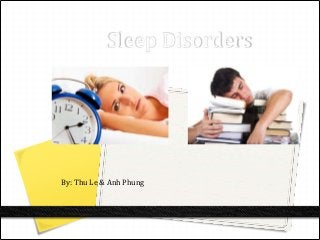
Sleep disorders
- 1. Sleep Disorders By: Thu Le & Anh Phung
- 2. Sleep Disorders Background 0 Types of sleep disorder 0 Insomnia 0 The inability to get the amount of sleep you need to wake up feeling rested and refreshed is the most common sleep complaint. Insomnia is often a symptom of another problem, such as stress, anxiety, depression, or an underlying health condition. It can also be caused by lifestyle choices, including the medications you take, lack of exercise, jet lag, or even the amount of coffee you drink. 0 Signs and symptoms: 0 Difficulty falling asleep at night or getting back to sleep after waking during the night. 0 Waking up frequently during the night. 0 Your sleep feels light, fragmented, or un-refreshing. 0 You need to take something (sleeping pills, nightcap, supplements) in order to get to sleep. 0 Sleepiness and low energy during the day.
- 3. 0Sleep apnea 0 A common sleep disorder in which your breathing temporarily stops during sleep due to blockage of the upper airways. These pauses in breathing interrupt your sleep, leading to many awakenings each hour. While most people with sleep apnea don’t remember these awakenings, they feel the effects in other ways, such as exhaustion during the day, irritability and depression, and decreased productivity. 0 Signs and symptoms: 0 Loud, chronic snoring 0 Frequent pauses in breathing during sleep 0 Gasping, snorting, or choking during sleep 0 Feeling un-refreshed after waking and sleepy during the day, no matter how much time you spent in bed 0 Waking up with shortness of breath, chest pains, headaches, nasal congestion, or a dry throat.
- 4. o Restless legs syndrome (RLS) • Sleep disorder that causes an almost irresistible urge to move your legs (or arms). The urge to move occurs when you’re resting or lying down and is usually due to uncomfortable, tingly, aching, or creeping sensations. • Signs and symptoms: Uncomfortable sensations deep within the legs, accompanied by a strong urge to move them. The leg sensations are triggered by rest and get worse at night. The uncomfortable sensations temporarily get better when you move, stretch, or massage your legs. Repetitive cramping or jerking of the legs during sleep.
- 5. Narcolepsy • A sleep disorder that involves excessive, uncontrollable daytime sleepiness. It is caused by a dysfunction of the brain mechanism that controls sleeping and waking. If you have narcolepsy, you may have “sleep attacks” while in the middle of talking, working, or even driving. • Signs and symptoms: • Seeing or hearing things when you’re drowsy or starting to dream before you’re fully asleep. • Suddenly feeling weak or losing control of your muscles when you’re laughing, angry, or experiencing other strong emotions. • Dreaming right away after going to sleep or having intense dreams • Feeling paralyzed and unable to move when you’re waking up or dozing off.
- 6. Sleep Shift Work Disorder 0 Circadian rhythms sleep disorder that occurs when your work schedule and your biological clock are out of sync. In our 24-hour society, many workers have to work night shifts, early morning shifts, or rotating shifts. These schedules force you to work when your body is telling you to go to sleep, and sleep when your body is signaling you to wake.
- 7. Things That Help To Get Better 0 Take regular breaks and minimize the frequency of shift changes. 0 When changing shifts, request a shift that’s later, rather than earlier as it’s easier to adjust forward in time, rather than backward. 0 Naturally regulate your sleep-wake cycle by increasing light exposure at work (use bright lights) and limiting light exposure when it’s time to sleep. Avoid TV and computer screens, use black-out shades or heavy curtains to block out daylight in your bedroom. 0 Consider taking melatonin when it’s time for you to sleep.
- 8. Sleep Studies (Lab Findings&Differential Diagnosis) 0 To tests that record what happens to your body during sleep; studies are done to find out what is causing your sleep problems 0 Sleep apnea, when an adult regularly stops breathing during sleep for 10 seconds or longer. This may be caused by blocked airflow during sleep, such as from narrowed airways. Or it may be caused by a problem with how the brain signals the breathing muscles to work 0 Problems staying awake, such as narcolepsy 0 Problems with nighttime behaviors, such as sleepwalking, night terrors, or bed-wetting. 0 Problems sleeping at night (insomnia). This may be caused by stress, depression, hunger, physical discomfort, or other problem. 0 Conditions such as periodic limb movement disorder, which is repeated muscle twitching of the feet, arms, or legs during sleep.
- 9. Sleep Studies (Lab Findings&Differential Diagnosis) 0 Polysomnogram. This test records several body functions during sleep, including brain activity, eye movement, oxygen and carbon dioxide blood levels, heart rate and rhythm, breathing rate and rhythm, the flow of air through your mouth and nose, snoring, body muscle movements, and chest and belly movement. 0 Multiple sleep latency test (MSLT). This test measures how long it takes you to fall asleep. It also determines whether you enter REM sleep. 0 Maintenance of wakefulness test (MWT). This test measures whether you can stay awake during a time when you are normally awake. 0 Body’s internal clock (circadian rhythm), you may have a test called actigraphy. For this test, you wear a device on your wrist that looks like a watch. The device measures your movement during sleep and when you are awake. It helps your doctor learn what times during the day you are active and what times you are sleeping.
- 10. Treatment 0 Relaxation training 0 Cognitive therapy 0 Stimulus control (SC) 0 Sleep restriction therapy (SRT) 0 Sleep hygiene
- 11. Psychotherapy for Sleep Disorders 0 Adlerian Therapy 0 Existential Therapy 0 Gestalt Therapy 0 Person-centered Therapy 0 Psychoanalytic 0 Reality Therapy 0 Transactional Analysis